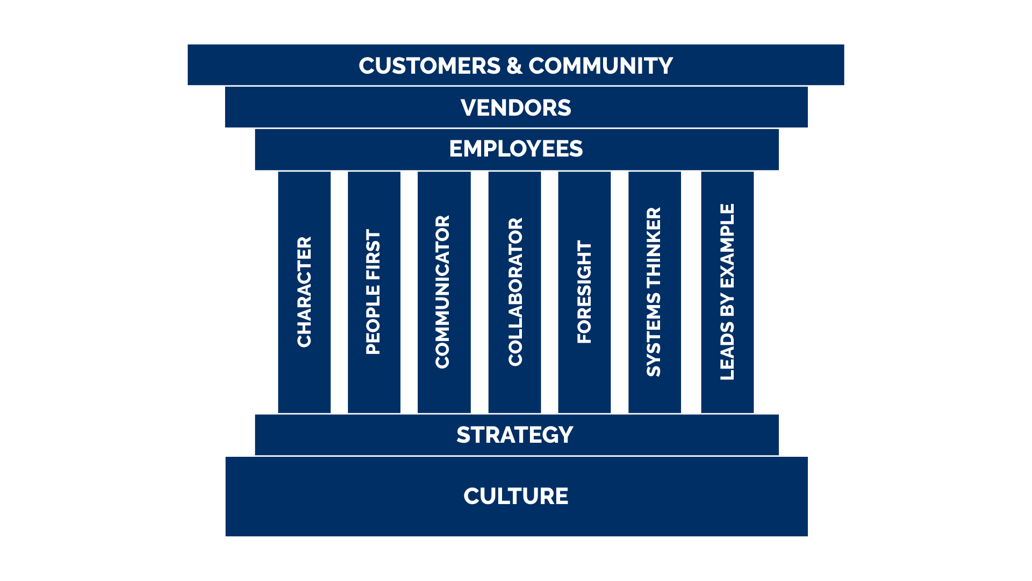- Vegetation Management Services
- In Your Neighborhood
- About
- Careers
- Webinars
- Articles
Servant Leadership in Utility Vegetation Management

Servant Leadership in Utility Vegetation Management
By C. Troy Ross, President, ACRT and ACRT Pacific
On a chilly Monday morning, a utility vegetation management crew gathers for their weekly briefing. Instead of launching into instructions, their supervisor begins by asking each team member how they’re doing. One mentions a child’s illness, another shares excitement about a certification course they just completed, and another raises a safety concern from last week’s job. The supervisor listens closely, takes notes, and makes commitments to follow up. Only then does the conversation turn to schedules and project updates.
This moment may seem small, but it illustrates something powerful: a leader putting the needs and voices of the team first. In an industry where disengagement, high turnover, and the pressures of managing a distributed workforce are constant challenges, this approach isn’t just compassionate, it’s strategic. It’s servant leadership in action.
Putting People First
Employees and vendors consistently say they want more than just fair pay. They seek fairness, empathy, a sense of purpose, and opportunities for growth. These expectations echo Maslow’s hierarchy of needs: only when individuals feel safe, supported, and valued can they truly invest in higher-level goals like achievement and self-actualization.
What they want from leaders is equally clear. They look for support that goes beyond empty promises — leaders who not only listen but also act on what they hear. They want accountability, consistent communication, and recognition for their contributions. They want training that invests in their future and a safe work environment where they can thrive. In short, they want leaders who are present, accessible, and committed to their success
Redefining Leadership

Traditional leadership often emphasizes authority and control. The traditional leader is the one doing most of the talking, focused on personal success, and measuring performance primarily through numbers. Leadership, in this model, is a badge of accomplishment.
Servant leadership flips this script. Servant leaders listen actively, empower their teams, and measure success not by their own achievements but by the growth and well-being of the people they serve. They see leadership not as a destination but as an act of service, a responsibility to uplift others and help them reach their potential
The Traits That Matter

The best servant leaders lead by example. They inspire not through authority but through humility, accountability, and influence. They are clear and positive communicators, strategic thinkers, and collaborators who prioritize people first. Empathy, stewardship, and a commitment to others’ growth define their actions. In many ways, they act as coaches, guiding individuals toward success while building the collective strength of the team.
These qualities make servant leaders more than managers. They are catalysts for transformation, creating workplaces where people feel supported and valued. And as research shows, this style of leadership produces measurable results.
Why Servant Leadership Works
The business case for servant leadership is compelling. Companies that embrace it see turnover drop by a quarter, while employee retention and morale rise. Engagement skyrockets: 70 percent of employees report higher satisfaction when their leaders practice servant leadership, and those employees are fourteen times more likely to stay with their organizations.
The benefits don’t stop there. Customer satisfaction increases by 20 percent, workplace conflicts decrease by 15 percent, and organizations report innovation scores 33 percent higher than peers. Productivity improves too, sometimes by as much as 30 percent. These results prove that servant leadership is not just about being kind, it’s about creating the conditions for sustainable performance
Source: WifiTalents, 2025
Building a Culture of Service
Of course, adopting servant leadership doesn’t happen overnight. Leadership expert Rick Conlow outlines a path forward that begins with defining what servant leadership means within your organization. Leaders and employees alike need education and training to understand how philosophy applies to their roles.
From there, companies must assess their culture, gathering feedback through surveys and focus groups to understand current strengths and weaknesses. Once that foundation is in place, leaders can set clear goals and metrics that align with servant leadership principles.
Training and development play a central role, ensuring that both leaders and team members are equipped to practice empathy, empowerment, and open communication. Empowerment is especially critical; it means giving employees ownership of their work, trusting them with decision-making authority, and backing that trust with resources and support.
Most importantly, leaders must lead by example. Servant leadership cannot be a program layered onto an existing culture; it must be a way of doing business. Leaders show its value by demonstrating empathy, listening actively, and prioritizing the needs of their teams in tangible ways
A Leadership Philosophy for Today
The workplace is changing. Remote and hybrid work models, technological innovation, and shifting employee expectations have transformed how organizations function. Employees want careers that feel purposeful, not just transactional. They want to know their leaders see them as people, not just workers.
Servant leadership meets these demands. By prioritizing growth and well-being, it creates environments where people feel valued and empowered. It fosters loyalty, encourages innovation, and strengthens resilience. In doing so, it transforms companies into communities where employees are not just surviving but thriving.
Conclusion
The Monday morning supervisor who starts with listening rather than directives may not make headlines, but their impact is meaningful. Servant leadership is built on moments like these: small choices that add up to a culture where people come first. It is leadership that redefines success, shifting the focus from authority to accountability, from control to empowerment, and from individual achievement to collective growth.
In today’s business climate, servant leadership is not simply a noble ideal, it is a practical necessity. Organizations that embrace it gain not only happier and more engaged employees but also stronger performance, greater innovation, and long-term resilience. The leaders who succeed in the years ahead will be those who understand that true leadership is not about being served, but about serving others to unlock their fullest potential.
This article was originally published in the 2025 November/December edition of the UAA Newsline.
Related Articles

Every year on Veterans Day, we pause to honor the men and women who have worn our nation’s uniform. They come from every background and every corner of the country, united by a common purpose: to serve something greater than themselves. Their service enriches our organization, and we are grateful for the impact they continue[...]
Read More
As we celebrate Employee Ownership Month this October, we are proud to highlight colleagues who have served on the ACRT Services Board of Directors. At ACRT Services, our independence as a 100% employee-owned company empowers every employee-owner to share in our success and play a role in shaping our future. This commitment reflects our mission:[...]
Read More
As we celebrate Employee Ownership Month this October, we are proud to highlight colleagues who have served on the ACRT Services Board of Directors. At ACRT Services, our independence as a 100% employee-owned company empowers every employee-owner to share in our success and play a role in shaping our future. This commitment reflects our mission:[...]
Read More
By Aana Agrawal, Sustainability and Resilience Manager, EnviroScience The utility vegetation management (UVM) sector plays a crucial role in ensuring the smooth transmission of power across regions and cities by keeping plant growth under control within the vicinity of transmission and distribution lines. However, unrefined vegetation maintenance practices often focus on trimming, cleaning, and disposal[...]
Read MoreRecent Posts
- Servant Leadership in Utility Vegetation Management 12th Nov 2025
- ACRT Pacific Honors Our Veterans 10th Nov 2025
- Rian Owens Receives Safety Challenge Coin 05th Nov 2025